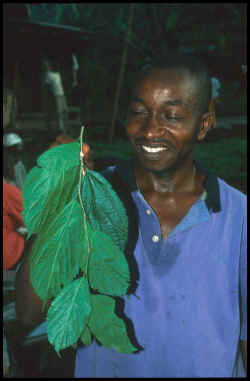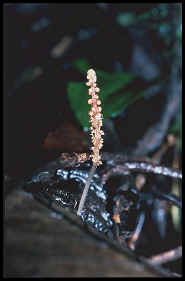Western Cameroon Projects: Mount Kupe & the Bakossi Mountains
MOUNT KUPE AND THE BAKOSSI MOUNTAINS
|
The Bakossi Mountains as viewed from M Kupe. |
The Bakossi Mountains, best known for the highest peak, Mount Kupe (2064 m), do not feature on many maps of Cameroon. They form part of the line of mountains that run roughly SW-NE along the fault line that represents a failed Atlantic Ocean. Inhabited by the Bakossi people, they cover an area of about 230,000 square Kilometres and contain what is possibly the largest area of cloud or submontane forest (c. 800-1900 m elevation) in West-Central Africa. Annual rainfall is 3-4 m. |
|
Kew projects Kew's involvement in the area began after a reconnaissance visit in 1993 when the Mount Kupe Forest Project (then managed by BirdLife International, later by WWF-UK and currently part of WWF-Cameroon but dormant) expressed interest in obtaining information on the plant species present for conservation purposes. Our botanical inventory work began with Earthwatch support in 1995 on Mount Kupe and extended to the Bakossi Mountains in 1998. Fieldwork was further supported by the Darwin Initiative (British Government) in 1999. CRES (Center for Reproduction of Endangered Species, managed by San Diego Zoo) at Nyasosso are our current main local partners. Concluding a "Plant Conservation Checklist" for Mount Kupe-Bakossi is a major focus for the Wet Tropical Africa group at Kew. This work is based on study of the c. 9,000 specimens gathered in the area in recent years, mostly on joint expeditions with the National Herbarium of Cameroon. The Bakossi botanist Martin Etuge is the most prolific single collector of specimens from the area. Martin Etuge, the most prolific collector of plant specimens from Mt Kupe and the Bakossi Mountains. Botanist at the CRES project, Nyasoso, he was the first to collect Kupea and many other new species to science. |
 |
New discoveries
 |
About 2000 species have so far been identified, of which 72 are new to science. Sixty species are restricted to the area, as far as is known, and many of these are of concern for conservation. Among the more interesting species that we have discovered is Kupea martinetugei (Triuridaceae) a new species of saprophyte, an achlorophyllous mycotroph, lacking photosynthetic tissue entirely. This critically endangered species, restricted to Mt. Kupe, is known from only two sites each of only a few square metres. It represents not only a new species to science, but a new genus, and a new tribe.
Kupea martinetugei (Triuridaceae), published in 2003, this endangered new genus, representing a new African tribe of its family, was first discovered at Mt Kupe. Only two locations, each of less than 20m x 20m, are known. |


